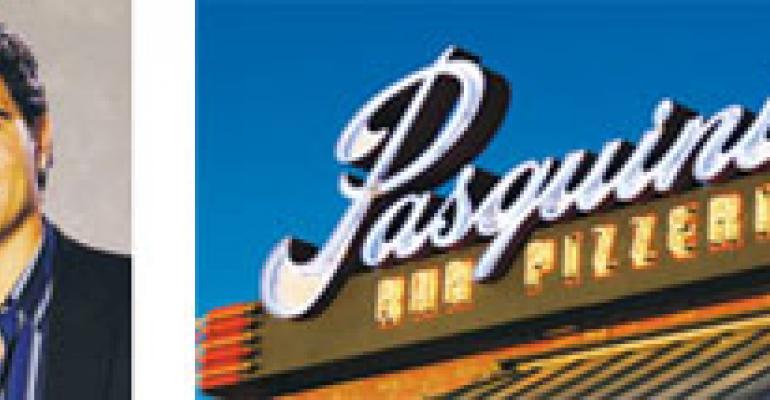If any shining graces emerge from the “Great Recession,” the effect of reducing real estate prices will be chief among them for expansion-minded operators.
“This is actually one of those rare, opportune moments in history for strong restaurant concepts to forge ahead of the pack,” says Gianmarco Macchiaroli, principal with Pasquini Franchising LLC of Denver. Pasquini’s, founded in 1986, just opened a fourth location of the neighborhood pizzeria concept in September.
In addition to benefiting from the decreasing real estate prices, Pasquini’s and other operators also maintain that flexibility in design will help provide opportunities for better locations and higher visibility.
P.J. Evans, senior vice president of franchise development for the 233-unit Fuddruckers chain of Austin, Texas, says: “Many businesses have vacated existing leases, and the majority of chains and their franchisees are not developing as aggressively as they had hoped. Accordingly, now is the time for strong brands like Fuddruckers to develop and expand.
“Rents are lower, and there are a plethora of opportunities for A-plus sites at reduced costs that might have made them prohibitive only a short time ago,” Evans says.
But while real estate costs may be moderating somewhat, operators acknowledge they are not out of the recessionary woods yet and near-term expansion will still require designs that accommodate less-costly buildings—particularly where credit remains tight.
El Pollo Loco, the 417-unit Mexican chain based in Costa Mesa, Calif., has created a “Gen3” unit designed to cut capital costs. In the company’s quarterly report, EPL said it was reducing expansion but had plans to emphasize a lower-cost unit.
“In response to the credit crisis, we are adjusting our growth strategy to focus on a new generation, [Gen3] reduced-cost restaurant that we believe will appeal to both single-unit and multiunit franchisees,” the company says. “The Gen3 is designed to offer the same features—with fewer seats and no salsa bar—of a typical 2,600-square-foot, freestanding, drive-thru restaurant, at about half the cost. The Gen3, which will range from 1,800 to 2,200 square feet, will have reduced construction costs and a shorter build-out period than our existing restaurant design.”
Similarly, Fuddruckers is working on a smaller-footprint store that Evans says will allow the chain “to go into in-line end caps of about 5,000-plus square feet.”
Some of the chain’s stores are as large as 7,000 square feet, he says.
“Ultimately, Fuddruckers is ‘real-estate neutral,’” Evans says, “because we have solutions and footprint sizes flexible enough for tight urban configurations as well as pad-sites at regional malls. Fuddruckers’ nontraditional venues of less than 1,200 square feet at malls and airports are also in place and performing quite well.”
Macchiaroli of Pasquini’s says he has seen real-estate prices drop about 40 percent in the Denver market and across the Front Range in Colorado, where the company has been recruiting new franchisees.
“This is definitely a boon to Pasquini’s franchise sales effort and certainly bodes well for Pasquini’s unit economics over the next five to 15 years for franchisees willing to get into the game now,” Macchiaroli says.
While still fairly new to franchising, Macchiaroli adds, Pasquini’s keeps an eye on costs.
“We’re focused on ‘smart-sizing’ our concept to further maximize revenue per square foot and diversify sales and guest demographics through a new use of space,” he says. “While our sales per square foot are approximately $490, which rivals top national Italian chains like Macaroni Grill and Johnny Carino’s, we know we can achieve better. In our last two locations we have diversified sales and guest demographics, and increased occasions by including a full, branded bar within the restaurant. Both units have done exceedingly well with this new use of space.”
He says Pasquini’s for the past 23 years has used 4,000 to 5,500 square feet for its units, but that may change as the company grows.
“We plan to continue experimenting with size and use of space as we expand in Colorado and beyond,” he says. “Before the market declined, ‘A’ space was only available to national brands with strong balance sheets. Now the playing field has leveled for a number of reasons, so burgeoning brands like Pasquini’s have access to ‘A’ space because demand dropped, thus, prices have dropped and national players aren’t necessarily the ‘safe bet’ they were once perceived to be.”
In addition, Macchiaroli says, landlords are becoming more generous with tenant-improvement money, rent abatement and slower ramp-ups to rent.
Evans of Fuddruckers agrees, saying: “Landlords are under great pressure because tenants are leaving, and they have an over-abundance of supply. We have found them very understanding of this economy and willing to renegotiate existing leases for our mutual benefit. Done in the spirit of win-win, a lot can be accomplished.”
The downturn has put many of Fuddruckers existing franchisees “in a prime position to take on excellent real estate at bargain prices,” he adds. “We plan to stay focused on our core brand values while taking advantage of these opportunities occurring in virtually every market we do business.”— [email protected]




